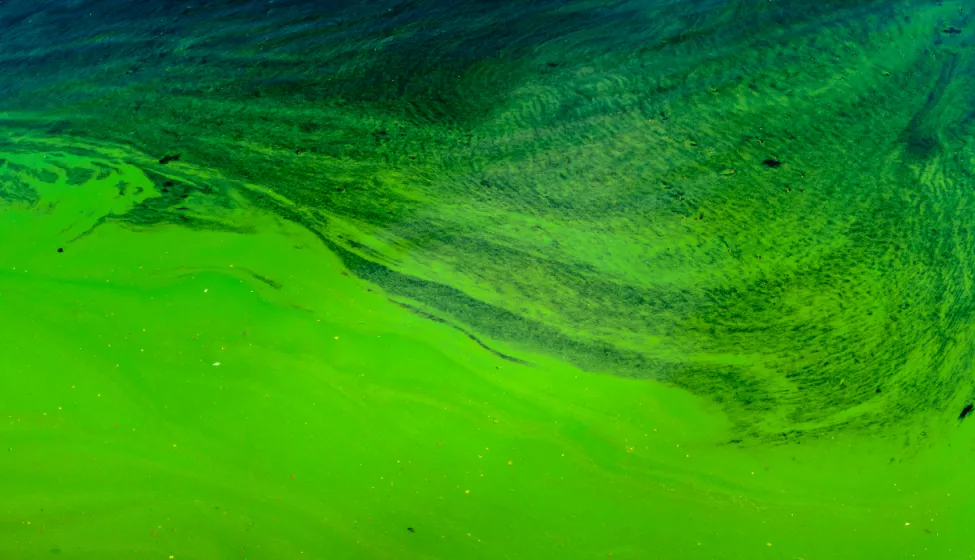August 2, 2022
Multiple federal agencies agree with GAO recommendations as occurrence of HABs & hypoxia rise
A recent report from the U.S. Government Accountability Office says government agencies should do more to manage human health and environmental risks from harmful algal blooms (HABs) and hypoxia. HABs can introduce challenges to drinking water supplies, creating the need for water system operators to monitor and manage algal toxins. Hypoxic events can also cause economic damage by impacting commercial and recreational fisheries.
HABs are rapid overgrowths or blooms of naturally occurring phytoplankton that degrade water bodies.
HABs can be unsightly, produce unpleasant odors, and even threaten the health of people and animals by production of toxins and hypoxic events with exposure by contact or ingestion.
Hypoxic or low-dissolved-oxygen events can occur after excess algae die and decomposition processes consume oxygen in the water. How HABs manifest depends on both habitat and algae species, so there can be many potential causes of HABs as well as many outcomes. HABs have become increasingly common and the risk of future HABs will increase over time.
Recognizing these threats, Congress passed the Harmful Algal Bloom and Hypoxia Research and Control Act of 1998 and subsequent amendments establishing an inter-agency working group tasked with assessing HABs and hypoxic events. This group was also tasked with defining a national program for monitoring and forecasting these events. The working group — co-chaired by the National Oceanic and Atmospheric Administration (NOAA) and the Environmental Protection Agency (EPA) — is expected to produce these materials and ultimately coordinate with state, local, and tribal governments to manage risks from HABs and hypoxic events.
In 2016, the working group produced a report fulfilling its legislated responsibility to define a national research plan and action strategy for HAB and hypoxia assessment. However, the GAO notes that a national program has not been implemented nor has the working group defined parameters to evaluate the program's success. The GAO outlined several recommendations to address these and other issues.
GAO recommendations
In the GAO's report, they offer six recommendations and a series of steps to implement a congressionally mandated national program for HAB research and control. These included that the working group should:
- Document and define what a national HAB and hypoxia program would entail, including identifying the program's resource needs.
- Develop performance measures to assess efforts towards the recommended goals from the Research Plan and Action Strategy.
- Develop an interagency framework to research needs and expand HAB and hypoxia monitoring in freshwater systems.
- Develop an interagency framework to identify resource needs to expand HAB and hypoxia forecasting in freshwater systems.
- Develop a national goal for the group focused on the prevention of HABs and hypoxia.
- Gather information on the costs and benefits of mitigation, control, and prevention actions for use by state, local, and tribal governments.
By the numbers
In response to these recommendations, NOAA and EPA provided written comments (appendixes VII and VIII of GAO report). Generally, both agencies agreed with the recommendations but expressed two main concerns. First, neither EPA nor NOAA has authority to influence restructuring of the other member agencies within the working group to define a national HAB and hypoxia program. Second, EPA saw challenges to compiling a more comprehensive body of information on the costs and benefits of mitigation, control, and prevention actions given limited budgets and resources. These concerns suggest that responsibilities and authority of the working group may need clarification before it can effectively manage HAB and hypoxia risks.
How Exponent Can Help
Exponent's interdisciplinary consulting staff has the expertise to assist clients in many aspects of managing water quality, including HABs and hypoxic events. Exponent's environmental scientists and engineers have substantial experience evaluating water quality and chemical and nutrient transport, as well as assessing potential causes of occurrences such as HABs through causal analysis. We can help identify water bodies that may be vulnerable to HABs and hypoxic events, provide input on the development of monitoring plans, and advise on mitigation strategies and water treatment. Our consultants are also skilled in evaluating environmental changes (biological, chemical, hydrological, and meteorological) that can impact the occurrence of HABs and in identifying site-specific historical occurrences of HABs and early-warning indicators of blooms. In addition, our human health scientists are well equipped to help clients understand the derivation of human health water quality standards, exposure scenarios, and human health risk for potential blooms.


